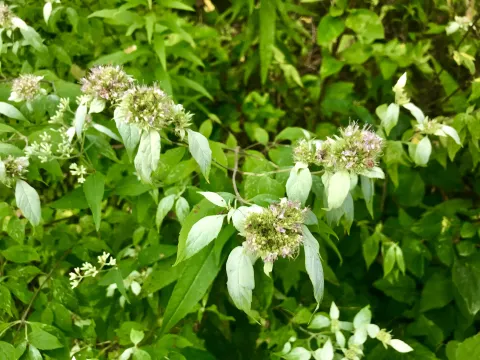Mountain Mint

Mountain Mint is easy to identify by its square stem, minty smell, and white dusty looking top leaves.
By Steve Roark
Volunteer, Cumberland Gap National Historical Park
Back in my mom’s day folks only had access to a few flavored drinks, like milk, coffee, and water. To make things more interesting, they would seek and use native plants that provided a nice change of taste. The more common ones used were sassafras tea, teaberry, spicebush, and my topic today, Mountain Mint (Pycnanthemum spp.). It’s easy to find along roadsides and woodland edges and makes a pretty tasty mint tea that also has medicinal value.
Like all mints, Mountain Mint can be identified by its square stem and aromatic leaves. The leaves are arranged along the stem in opposing pairs. The plant stands 1-3 feet tall and has branching clusters of roundish flower heads on which a few flowers bloom at a time. The flowers, which bloom from July to September, are small, white to purple, and lipped (the lower petal protrudes out more than the others). The upper leaves appear whitish as though they have been dusted with flour.
The leaves and flower ends can be used either fresh or dried to make an herbal tea that is flavorful and said to have some medicinal value. If you try it use only a small amount the first time in case of food allergies. Besides flavoring a beverage, the mint has been used to flavor meat while cooking. Medicinally, it has been used to treat coughs, colds, a decongestant, and relieve gas, and as a refrigerant (gives sensation of coolness to the body). Native Americans used the leaves to treat wounds and placed crushed leaves on a toothache to relieve pain. A mint poultice was placed on the forehead to relieve a headache.
Mountain Mint is easy to grow as an herb in your garden and is also considered a good pollinator plant to attract butterflies.
- Log in to post comments